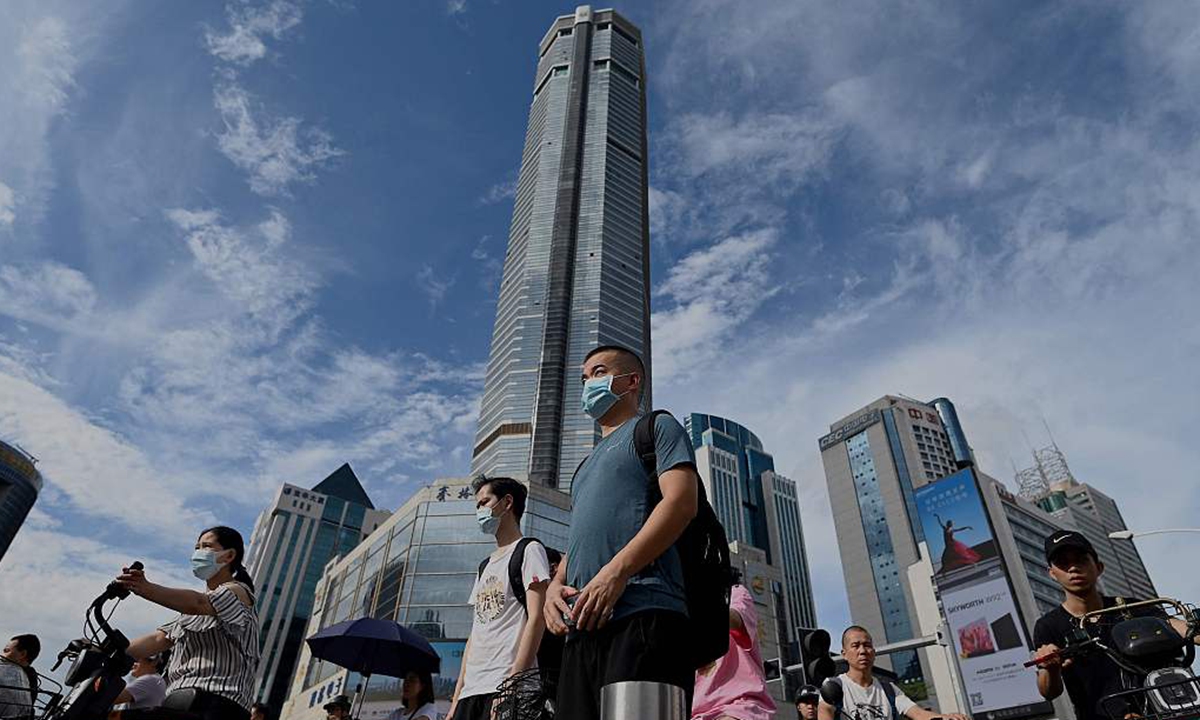
People walk past the temporarily closed 300-meter SEG Plaza in China's tech hub Shenzhen, South China's Guangdong Province on May 24, 2021. Photo: CFP
Six Chinese ministries jointly issued a guideline over the weekend saying that by 2025, the nation aims to develop 10,000 "little giant" enterprises that specialize in niche sectors and 1,000 enterprises that are champions in a single industry, as well as groups of leading companies.
Industry observers said that the guideline underscores China's strategic policy shift in the next five years to focus on breakthroughs in specific and critical sectors and supply chains where the country may be vulnerable amid a spiraling technology war between the world's two largest economies.
Preserving a large, complete domestic manufacturing sector could remain a key in the overall blueprint, but China will also widen its effort in building homegrown "hidden champions" - small and medium-sized enterprises (SMEs) that dominate major markets in niche sectors - to close gaps with the likes of the US, Japan and Germany in advanced manufacturing.
Among the six ministries were the Ministry of Industry and Information Technology (MIIT), the Ministry of Science and Technology, the Ministry of Finance, and the Ministry of Commerce.
They proposed setting up a work mechanism to guide specialized SMEs to grow into "small giant" companies in key sectors of the domestic market and champions in the international market.
Large groups will also be guided to become globally competitive leaders. Such a "gradient pattern" in manufacturing is expected to be formed by 2025.
Other measures in the guideline involve improving the capacity for independent innovation, facilitating the modernization of industry and supply chains, and improving financing and talent building policies.
An MIIT official said that this effort is necessary to stimulate the vitality of market entities and promote the high-quality development of the manufacturing sector. It will also prevent risks and improve the self-sufficiency of industry and supply chains.
"This is a lesson that we learned from the US' crackdown against China's technology rise. In the 13th Five-year Plan (2016-20) period, we prioritized market scale and industry output, but the heated technology war between China and the US exposed the risks of lacking 'hidden champions' in bottlenecked industries," Tian Yun, vice director of the Beijing Economic Operation Association, told the Global Times on Monday.
Analysts said that the "hidden champions" - exemplified by the Netherlands-based lithography equipment maker ASML - are of strategic importance to the new round of global manufacturing competition.
The US, Japan and Europe, which have already gained footholds in niche sectors, are doubling down efforts to make up any gaps and cement their leading positions.
The Biden administration is reportedly conducting a supply chain review in sectors that are critical to the US economy, including semiconductors and large-capacity lithium batteries. The move aims to address vulnerabilities and strengthen domestic manufacturing capabilities.
"China accumulated rich experience in developing industry titans like Huawei in the past. Now we need to switch the policy emphasis to climb up the manufacturing ladder in the
14th Five-year Plan period (2021-25)," Tian said.
Efforts are already underway in China. A third-generation semiconductor industrial base being developed by Bronze Technologies is under construction in Shenzhen, South China's Guangdong Province. The project, with a total investment of 350 million yuan ($54.17 million), has been listed as a major project of the city in 2021 and marks a fresh effort by local authorities to speed up the chip sector's development.
Analysts said that China is still on the second and third rungs in advanced manufacturing, but it leads in such sectors as 5G, quantum communications and aerospace.
Hu Qimu, chief research fellow at the Sinosteel Economic Research Institute, told the Global Times on Monday that China's complete industry chain, plus a systemic advantage and abundant talent supply, could aid the country in an all-out sprint to narrow gaps with the likes of US and Europe.
China is now the world's largest manufacturer, with industrial value-added reaching 31.3 trillion yuan in 2020. It is also the world's only economy to have all industrial categories listed by the UN, according to media reports.
"Making breakthroughs in chokehold sectors requires investment over a decade, and we may see some initial results in the next five years," Tian said.




